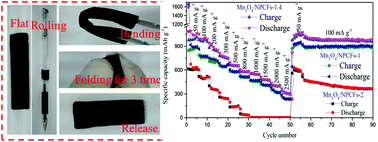Mn3O4/nitrogen-doped porous carbon fiber hybrids involving multiple covalent interactions and open voids as flexible anodes for lithium-ion batteries†
Abstract
Nanophase Mn3O4 with a grain size of about 7 nm was successfully synthesized by a novel sol–gel route. To improve the electrochemical performance, the Mn3O4 grains were incorporated into metal organic framework-derived (MOF-derived) nitrogen-doped highly porous carbon fibers (NPCFs), which were synthesized by the electrospinning technique. Two major keys to this work are the facile green synthesis of flexible Mn3O4/NPCFs-1.4 anodes and the better utilization of the active phase (Mn3O4) in Mn3O4/NPCFs-1.4 composites. When used as a flexible anode for lithium-ion batteries (LIBs), Mn3O4/NPCs-1.4 exhibited an excellent flexibility and a good electrochemical performance with a high specific capacity (1058 mA h g−1 at 50 mA g−1), good cyclability (no obvious capacity degradation even after a long-term cycling test up to 500 cycles) and an excellent rate capability (320 mA h g−1 at 2500 mA g−1). Such an excellent anodic property can be attributed to the presence of open voids in Mn3O4/NPCF hybrids, the robust one-dimensional (1D) structure of NPCFs and the multiple strong interactions between Mn3O4 and NPCFs, which collectively ensure the integrity of Mn3O4/NPCF membranes. The sufficient open-void spaces can accommodate the volume change and ensure high Li+ flux during the Li+ intercalation/deintercalation process. The robust 1D structure combined with the good electrical conductivity of NPCFs provides more efficient paths for ions and electrons to transfer rapidly. The excellent electrochemical performance, environmental compatibility, facile synthesis strategy and low cost of the manganese-based materials reveal the promise of Mn3O4/NPCFs-1.4 composites for practical applications.



 Please wait while we load your content...
Please wait while we load your content...